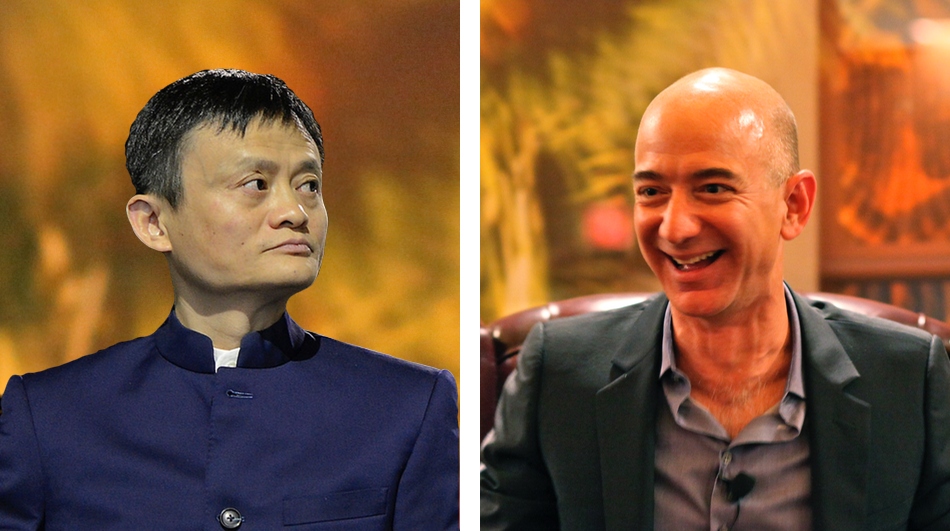
Photo montage by Tech in Asia. Photos by Steve Jurvetson and UN climate change.
Chinese companies seldom get credit for innovation and entrepreneurialism because they’re seen to be winning over global competitors in a protected market at home. But now, as China’s cash-rich tech giants move out into global markets, they have a chance to prove they can win on neutral ground, too.
Last month in Alibaba-owned UCWeb’s headquarters in Guangzhou, I got a glimpse into its keenness to take on the likes of Google and Facebook outside China’s walled garden. “Instead of competing with global companies in China, we’re competing with them in India, which is an open market,” Alibaba Mobile Business Group president Jack Huang told me in an interview. The UC Browser, which comes preloaded on Chinese smartphones flooding global markets, is the most actively used mobile browser in India, according to StatCounter.
See: Inside Alibaba-owned UCWeb’s plan to outwit Google and Facebook in Asia
Now, it appears we’re in for a much bigger showdown – the mother of all ecommerce battles between Alibaba and Amazon on the neutral and vast, open territory of India. Unconfirmed reports say Alibaba is pumping US$200 million into India’s mobile commerce and payments company Paytm, on top of the US$680 million it had invested along with its Ant Financial spin-off in 2015.
As China’s cash-rich tech giants move out into global markets, they have a chance to prove they can win on neutral ground, too.
What’s significant is that Alibaba’s fresh investment is being made in Paytm E-commerce. Paytm’s parent company One97 Communications recently split Paytm into two entities – Paytm E-commerce and Paytm Payments Bank. Paytm founder Vijay Shekhar Sharma sold 1 percent of his personal holding in One97 to invest US$48 million in Paytm Payments Bank and holds a 51 percent stake in it.
The payments bank is a special entity created in India to facilitate a push toward a digital economy and financial inclusion. It is limited to payments and cannot give loans directly like traditional banks. The Reserve Bank of India has issued licenses to 11 payments banks, including Paytm’s, which will encompass its digital wallet.
See: Paytm founder prepares for his next pivot, which could be the biggest yet
The payments bank is similar in concept to Alibaba’s MyBank in China, but banking regulations are different in India. That is partly the reason Paytm split into two and Vijay Shekhar Sharma took a majority stake in the payments bank, complying with RBI requirements.

Vijay Shekhar Sharma, founder and CEO of Paytm. Photo credit: Tech in Asia.
Now comes the other part of the story. Alibaba’s new investment would take its total stake in Paytm E-commerce to over 50 percent. This serves twin purposes – it keeps the Chinese company off the radar of skittish Indian banking regulators who’ve delayed the launch of Paytm’s payments bank, and it lets Alibaba take the lead in an Indian ecommerce business.
Alibaba probably finds it easier at the outset to start a new site instead of taking over a struggling business.
Alibaba has so far held off from entering the ecommerce arena in India directly like Amazon, preferring to pick up stakes in Paytm and another ecommerce player Snapdeal, instead. Now it is making its move with Paytm E-commerce, which is expected to launch a new website called Paytm Mall as an Indian version of Alibaba’s Tmall ecommerce marketplace in China.
There were rumors earlier of Alibaba acquiring Snapdeal, but the Chinese company probably finds it easier at the outset to start a new site instead of taking over a struggling business. Both of India’s top-funded ecommerce companies, Flipkart and Snapdeal, saw their valuations plummet last year. Their discount-led attempts to grab market share have come unstuck against Amazon, which put a US$5 billion bet on winning India.
See: Thrillers to tragedies: what ails Flipkart, Snapdeal
Consumer will decide the victor

Photo credit: byheaven / 123RF.
India’s ecommerce pioneer, K Vaitheeswaran, who had to shut down Indiaplaza in 2013 after running it for 14 years, was a victim of the VC-funded discounting that gained momentum around that time. Amazon’s entry escalated the discount wars but it soon became clear that the American giant couldn’t be out-funded. On the contrary, Amazon poured billions more into India last year even as Flipkart and Snapdeal struggled to raise funds.
In China, the government decides the victor. In India, the consumer will decide the victor.
Alibaba’s entry with a formidable war chest is the next act in this epic drama. But Vaitheeswaran believes Amazon can’t be beaten with money, as Tiger Global-backed Flipkart and SoftBank-backed Snapdeal found out. “Whatever Alibaba brings, Amazon can match. The only way to win this is to provide superior customer experience – and Amazon holds the gold standard in that.”
Amazon’s inability to rise above being a fringe player in China has more to do with restrictive rules than customer experience. India is different. “In China, the government decides the victor. In India, the consumer will decide the victor,” Vaitheeswaran points out to me.
As an Amazon user myself, I have to tick most boxes in its customer experience scoresheet. Deliveries are reliable, on time, and conveniently left with neighbors when I’m not around. Returns and cancellations are easy, and communications are helpful and efficient without being obtrusive.
Subscribing to Amazon Prime is a no-brainer at a grand annual fee of INR 499 (US$7.4), which includes streaming of free movies and TV shows, including local ones. That’s how much it costs to watch a single movie in a theater. Prime members who start enjoying free deliveries, early access to deals, and the Amazon experience would lose interest in other sites, unless they have a compelling differentiator.
See: Why the arrival of Amazon Prime is a key milestone in winning India
The differentiators are getting harder to find. One area that Amazon is yet to crack in India is online grocery, so India’s BigBasket rules this sub-domain – for now. There are niche ecommerce sites with some traction. And there’s also the Shopclues play for consumers who go for cheap, unbranded apparel, where the value for money is hard to establish.
But in most categories, especially in branded goods, both the pricing and selection on Amazon are hard to match. Amazon’s international vendors cater to urban Indians’ taste for Western goods. A consumer research report by PayPal and Ipsos shows Indians spent US$9 billion on international websites in 2016 – predominantly American.

Chinese smartphones are killing it in India. Photo credit: Mi India.
This could change with the entry of Alibaba bringing competing Chinese goods at attractive price points. Chinese smartphones are killing it in India and consumer goods brands like Haier have overcome earlier skepticism over the quality of Chinese products.
It will take time for Indian consumers to embrace Chinese apparel, cosmetics, and food products with as much enthusiasm as they show for smartphones and electronic appliances. But Alibaba’s growing presence in the US has opened a new channel for Western goods to reach Asian consumers.
Tmall Global surged last year to 14,500 brands from 63 countries, reports China Internet Watch. The biggest sellers were retailers from the US, Japan, and South Korea, 80 percent of them entering China for the first time via Alibaba’s cross-border ecommerce marketplace.
See: Alibaba’s UCWeb bets $30m on expanding browser into news channel in India
At a meeting with US President Donald Trump last month, Alibaba co-founder and chairman Jack Ma said US exports to China through Alibaba’s ecommerce marketplaces would support one million new American jobs. But just a month earlier, the US put Alibaba’s consumer-to-consumer marketplace Taobao on a list of “notorious markets” for counterfeit goods. “We question whether the US Trade Representative acted based on the actual facts or was influenced by the current political climate,” responded Alibaba, pointing out that 100,000 brands operate on its platform.
The smartest player here is the Indian consumer.
Alibaba may find it hard to stop Amazon in the US with one hand tied behind its back. The American giant increased its market share on home ground last year, accounting for 43 percent of all online retail sales in the US, according to Business Insider.
India could be a different story, because it is a more open market. But Amazon has a head start on warehousing infrastructure, delivery processes, and most of all, in winning the Indian consumer’s trust. Alibaba’s partnership with Paytm, and insights from working with Snapdeal, lessen the gap but don’t close it. Both the Chinese and Indian markets are massive and predominantly mobile: that could be a factor in Alibaba’s favor, especially with the rise of UC Browser.
See: India now has 462 million internet users – mostly mobile

Photo credit: leungchopan / 123RF Stock Photo.
I ask Vaitheeswaran what he thinks of possible synergies with Paytm working in Alibaba’s favor – such as Paytm wallet users being guided to its new Alibaba-led ecommerce site. He again points out to me that there’s no Chinese walled garden in India. Everyone is aware of the major ecommerce sites, and most consumers shop on multiple sites to find the best deals and experiences. “If Paytm users hadn’t heard of Amazon, it would work. But that’s not the case in India,” says Vaitheeswaran. “The smartest guy here is the Indian consumer.”
The luckiest too, as the world’s two biggest ecommerce players battle it out to win the hearts and minds of Indian consumers with value-for-money pricing, a vast selection of things to buy, and a customer experience that makes online shopping a joy.
The battle also comes in the backdrop of momentous changes in India. Three months ago, India’s prime minister took a drastic step to curb the use of cash and give a push to digitizing the economy. Despite chaotic implementation, going cashless could have multiplier effects. Demonetization – as well as course correction by Indian ecommerce players after the extravagant discounting in previous years – took its toll on growth last year. But it’s expected to pick up smartly again.
The battle for domination of global ecommerce is about to escalate into a world war.
India is now second only to China in number of internet users – 462 million. And four-fifths of them access the web from mobile devices. As mobile payments become easier with digital wallets, payments banks, and a unified payments interface, it opens new opportunities.
If Alibaba sees success, it will pave the way for other Chinese internet businesses to play on Indian turf. Where does that leave India’s leading ecommerce players Flipkart and Snapdeal? Not in a happy place. The best outcome may be an acquisition, albeit at a fraction of the crazy valuations they had hit in the heydays of 2015.
Alibaba’s acquisition of a controlling stake in Southeast Asia’s Lazada, which in turn bought online grocery store Redmart, may be a pointer. Ironically, while Amazon waits in India for its big challenger to arrive from China, it’s the other way round in Southeast Asia. Alibaba-backed Lazada dominates the ecommerce scene there, which Amazon is expected to enter soon. The battle for domination of global ecommerce is about to escalate into a world war.
This post Ready, set, fight! Alibaba and Amazon battle on India’s neutral ground appeared first on Tech in Asia.
from Tech in Asia https://www.techinasia.com/alibaba-vs-amazon-in-india
via IFTTT
No comments:
Post a Comment